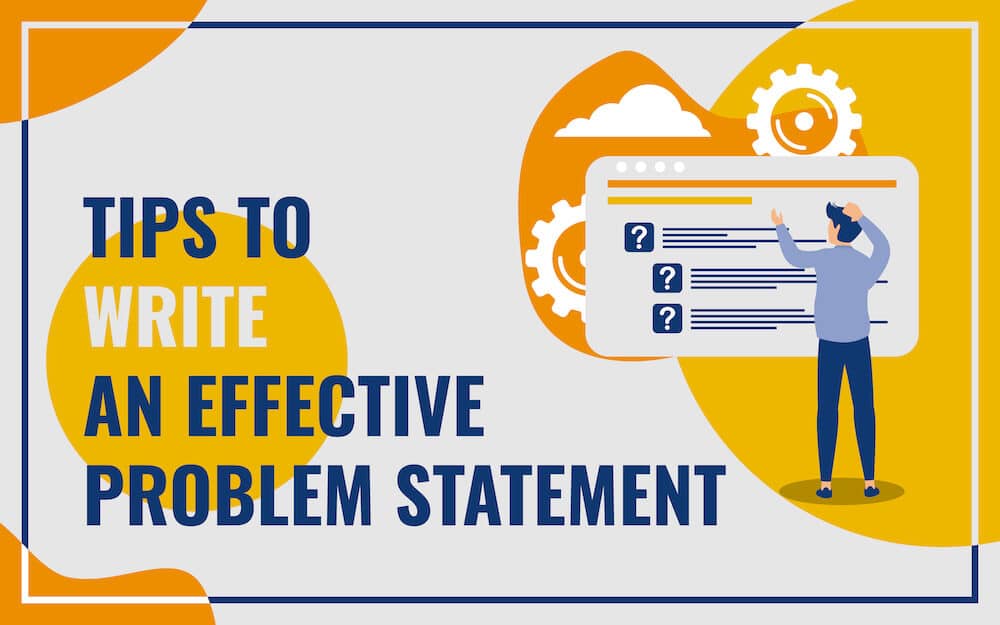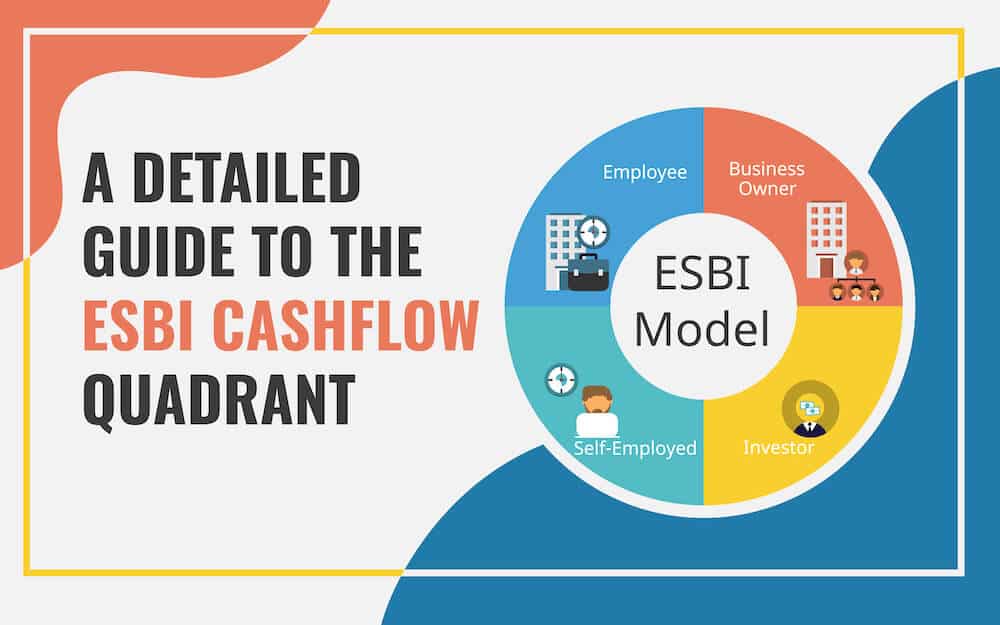
Suppose you have established a marketing venture and have hired staff at all levels, from interns to managers. There are multiple clients being handled by your teams simultaneously. However, one day, there was a client grievance regarding performance, another complained of poor graphics, and the third was unsatisfied with the pricing and plans. Your team members began hunting for the perfect solutions, and the entire office got involved. After wasting a couple of days, the manager was finally informed, who then solved the issue. What a mess, isn’t it? Would this not have been simpler if the customer desk knew whom to contact if they could not solve an issue on their own? Of course, it would be.
Well, to avoid all the chaos and work in an organized manner, escalation matrices were developed. These allow you to create a framework and direction for businesses, where every individual knows whom to approach and what to do next. Be it solving customer issues or managing projects, each process can be broken down into more straightforward and more structured steps with the help of these matrices.
In this dynamic and competitive landscape, challenges and issues are inevitable. The ability to address these hurdles promptly and effectively is crucial for success. Therefore, an escalation matrix is a vital tool that empowers teams to navigate obstacles efficiently and precisely.
In this article, we will understand the significance of an escalation matrix and look at some examples of how you can incorporate them into your business processes.
Importance of Escalation Matrix
1. Streamlining Communication
One of the primary benefits of an escalation matrix is its role in streamlining communication within a project. It defines clear lines of communication, specifying who to contact when issues arise. This clarity ensures that problems are promptly directed to the right individuals or teams with the necessary expertise to address them. Effective communication channels prevent confusion, avoid mismanagement, etc.
2. Ensuring Prompt Issue Resolution
In any project, the timely resolution of issues is crucial to prevent bottlenecks and keep the project on track. An escalation matrix ensures that problems are escalated to the appropriate level of authority as they arise.
By defining escalation levels based on issue severity and complexity, project teams can quickly address problems before they turn into major roadblocks. This proactive approach allows for corrective action, minimizing delays, and keeping the project on schedule.
3. Establishing Accountability
Accountability is a fundamental aspect of successful management. An escalation matrix clearly defines the roles and responsibilities of each project team member. It empowers individuals to take ownership of their tasks and decisions and ensures that issues are addressed by the most appropriate stakeholders. This clear assignment of responsibility fosters a culture of accountability within the project team, promoting efficient problem-solving and decision-making.
For example, consider a healthcare project involving the implementation of new medical gear. The staff discovers a malfunction in the equipment while installing them, which may further impact the patients. Between the time crunch and completion deadlines, isn’t it normal for the staff to panic and enter chaos? Of course, it is.
However, if there is a designated escalation matrix, there would absolutely be no anyway, and the problem would be resolved in the blink of an eye. In such a case, the head nurse would contact the technical support head, and their team would look into the matter.
Thus, clearly defined roles empower individuals to address critical issues and promote a culture of responsibility.
4. Mitigating Project Risks
Every project is associated with certain risks and uncertainties. An escalation matrix plays a crucial role in risk mitigation by enabling early detection and management of potential threats. By swiftly escalating risks to the appropriate level, project teams can take proactive measures to reduce their impact. This ensures that risks are addressed before they escalate into significant challenges, safeguarding the project’s success.
Ways to Incorporate Escalation Matrix in Your Business
Now that we’re clear with the importance of the escalation matrix, it is important to understand how you can integrate it into our daily business processes and use it to run your venture efficiently.
Well, the most important step is to educate your team about this matrix. You can do so by delivering informative presentations. And, if you don’t have enough time to create a presentation from scratch, you can use pre-designed templates. Remember, a well-informed workforce is instrumental in boosting customer satisfaction and ensuring a delightful customer experience.
We have provided a few examples of escalation templates that can be easily added to your presentations and can be completely customized according to your needs. These will save much of your time and prevent the hassle of crafting matrices from scratch.
1. Project Escalation Matrix
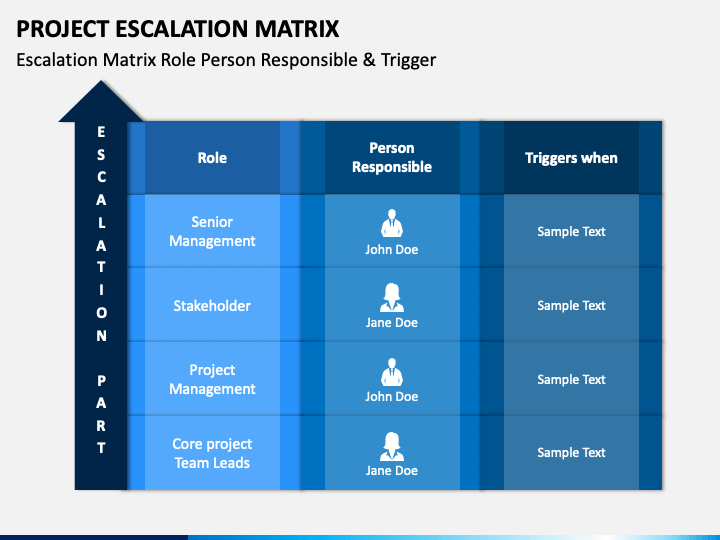
If you’re working on a project, this is a must-have matrix for you. It is a powerful tool designed to assist project managers and teams in effectively managing and addressing potential issues and risks that may arise during a project’s lifecycle.
Let us consider a construction project where a team is building a high-rise commercial building. During the construction phase, they encounter a delay in obtaining necessary permits from the local authorities. This delay can impact the overall timeline and budget.
With the help of a project escalation matrix, the team quickly identifies the issue and refers to the matrix to understand the appropriate escalation path. It clearly states the roles and responsibilities of key executives involved in the project, such as the project manager, construction manager, legal team, and city officials.
The concise escalation paths and defined responsibilities enable the team to take swift action, eradicating potential delays and ensuring the project stays on track. By providing an objective approach and clear accountability, it empowered the project team to address challenges proactively, ensuring the project’s success and timely completion.
You can showcase escalation paths, roles, and responsibilities and streamline communication and foster a culture of accountability within the project team with the help of a customizable Project Escalation Matrix template.
2. Escalation Pyramid
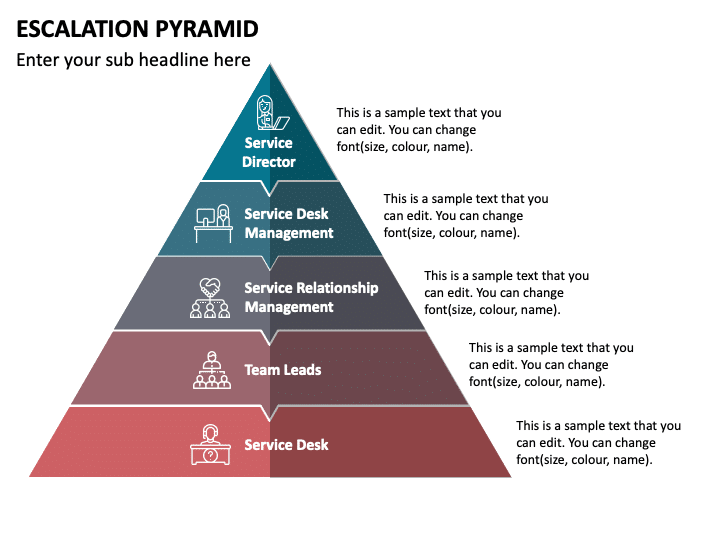
This is a valuable tool that enables teams to manage issues and conflicts efficiently, ensuring that they are resolved at the appropriate levels of authority. It defines clear escalation paths, from lower-level issues handled internally to higher-level problems requiring involvement from senior management or stakeholders.
Let us understand with the help of an example- consider a technology company that is developing a complex software application. During the testing phase, the development team discovers a critical bug that affects the application’s core functionality. They attempt to resolve the issue internally but find that it requires specialized knowledge and expertise beyond their scope.
Here, an informative presentation with a well-designed Escalation Pyramid template can help in making your team members well-prepared to handle such situations. It depicts a clear escalation path, starting from the bottom of the pyramid, which represents the lower-level issues that can be resolved within the team. As per the defined escalation, the development team promptly escalates the critical bug to the next level, which involves senior developers and technical experts.
However, if they recognize that the issue requires further escalation to the top of the pyramid, which represents the highest level of authority, typically involving senior management or stakeholders, they can further escalate it.
Thus, an information-rich presentation can help you educate your team on streamlining issue resolution, minimizing delays, and ensuring that problems are resolved with the right level of expertise and authority.
3. Customer Complaints
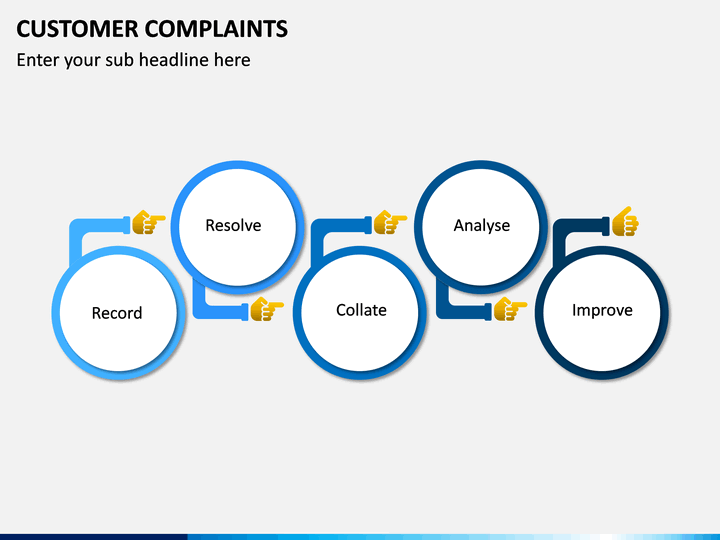
Handling customer complaints is a task in itself- it requires utter patience and sheer dedication. However, it is extremely crucial for businesses to handle the problems of their clients effectively to ensure consumer retention and loyalty.
The Customer Complaint template showcases a comprehensive guideline for acknowledging customer grievances, identifying the root causes of their concerns, and implementing solutions to resolve the issues.
By delivering a comprehensive presentation to your customer support team, you can align them with your goals of enhancing customer satisfaction. You can also educate them on how to log and acknowledge every single client’s grievance and handle them better. You can also provide insights into how to categorize the issues based on their nature and severity and use this data to further improve the business.
Conclusion
The importance of an escalation matrix in project management cannot be overstated. It serves as a catalyst for transforming complex processes into simpler ones and improves the productivity of the organization.
With clear lines of communication and a structured approach to issue resolution, an escalation matrix empowers teams to tackle challenges and deliver successful projects confidently. Let us know what you think about it in the comments section below.
